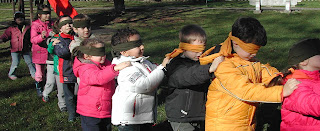jueves, 1 de agosto de 2013
martes, 16 de julio de 2013
HOW WILL BE EDUCATION´ FUTURE: Open, Massive, Online
We can see how increase the Higher Education offers, thanks to the massive expansion of the Internet and the emergence of new models of e-learning, which enhance the use of the image and the audiovisual resources and to facilitate interaction between teachers and students. New Technologies, after ICT (Information and Communication Technologies), is now LCT (Learning and Communication Technologies ). This requires us like teachers to develop new digital skills that allow us to know new methodologies and teaching resources: Open Social Learning (OSL) in distance higher education, Learning Management Systems (LMS), Personal Learning Environment (PLE), Massive Offering Open Courses (MOOC) Flipped classroom where the lecture is broadcast and face session is reserved for teamwork, resolving doubts and personalized tutoring or group.
MANAGEMENT CREATIVITY & INNOVATION IN EDUCATION
WELCOME AND INTRODUCTION
Dear participants:
In expectation of a new international educational experience I should like to welcome to the course and my module. Teachers and students in a summer time, we will be working and learning together trying to be creative and innovative. In my contribution I intend to show how we can use ICT in the best way for communication, learning and teaching. Each working group will develop a blog that is updated daily and where events, new materials and overall contributions are developed and exposed. All blogs will be connected to one central blog for the course for which I will be responsible.
Well, first of all I would like to introduce myself: I am Francisco Pavón Rabasco, Comunicar team and Cadiz University lecturer in New Technologies for Education in Primary School Teacher Training. All the articles written in scientific magazines and extracts from chapters of books, and books such as Information and Communication Education with New Technologies, refer to the use of New Technology in schools, and lifelong learning. I like nature, cycling, swimming, skiing, traveling and meeting people.
domingo, 23 de junio de 2013
MAKING VIDEOS
I present some tools that are more related to making short videos in which you can enter the characters and the text or comments that say:
Dvolver. The advantages of this tool is that it is not necessary to register. You can choose characters, stage background or venue of the texts will be read after the snacks of the conversations between the characters, introduce music and more.
stupelflix. With this you can select pictures and music and make a simple video. The same program will be creating movement between frames. The advantage is that the first video has no time limit.
animoto. Basically it works as I have described above. The advantage is that it has many themed templates to choose from. The disadvantage is that in its free version is limited to a certain number of photos and a maximum of 30 seconds.
Vokie. This is the simplest of all. You can choose a character (is good to work in another offer language descriptions) and a short text that character later say in different languages. It is a simple tool that can give your game.
Dvolver. The advantages of this tool is that it is not necessary to register. You can choose characters, stage background or venue of the texts will be read after the snacks of the conversations between the characters, introduce music and more.
stupelflix. With this you can select pictures and music and make a simple video. The same program will be creating movement between frames. The advantage is that the first video has no time limit.
animoto. Basically it works as I have described above. The advantage is that it has many themed templates to choose from. The disadvantage is that in its free version is limited to a certain number of photos and a maximum of 30 seconds.
Vokie. This is the simplest of all. You can choose a character (is good to work in another offer language descriptions) and a short text that character later say in different languages. It is a simple tool that can give your game.
lunes, 17 de junio de 2013
sábado, 8 de junio de 2013
domingo, 19 de mayo de 2013
jueves, 9 de mayo de 2013
miércoles, 1 de mayo de 2013
lunes, 29 de abril de 2013
OUTDOOR LEARNING
How do we learn about the world around us? Can we deliver better learning? How can science help to change behaviours towards a more sustainable world? These are just some of the questions that the Real World Learning Network is exploring.
SCHOOL KILLS CREATIVITY
Sir Ken Robinson, dice: “Los niños arriesgan, improvisan, no tienen miedo a equivocarse; y no es que equivocarse sea igual a creatividad, pero sí está claro que no puedes innovar si no estás dispuesto a equivocarte, y los adultos penalizamos el error, lo estigmatizamos en la escuela y en la educación, y así es como los niños se alejan de sus capacidades creativas”.
Pueden leer más en el siguiente artículo
domingo, 10 de febrero de 2013
Summer School
Effective Management of Creativity and Innovation: Theories & Best practices
from the fields of Psychology, Education, Business &
Engineering
University of Applied Management (UAM) acting as Project's
coordinator came about to lauch an International Erasmus Intensive Program that
covers wide thematical spectrum of Creativity and Innovation.
Sponsored by the German Academic Exchange Service (DAAD), the program's
implementation is possible due to its colaboration with different european
partner Universities. The idea behind the Intensive Program is based on
the interdisciplinary approach toward creativity and innovation. It has been
argued, that having combined new knowledge rooted in different domains
participants are prompted to develop different ways of thinking and therefore
boost own ability to solve problems creatively. Intensive program is regarded
as an unique learning platform for students not only to acquire new knowledge
across various domains but also to learn how to enhance and foster
one's creative thinking.http://www.emci.fham.de/Introduction.12614.0.html
Suscribirse a:
Entradas (Atom)




